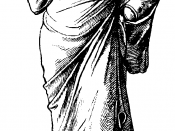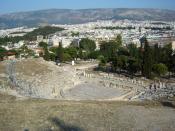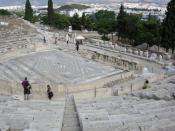When ancient Greek theatre is referenced to, it normally means Greek theatre in Athens during the fifth century. The ancient Greek theatre actually consisted of loud music, bright colors, and extensive dancing. Their plays showed violence and daily life, social and ethical plays, war, murder, lust and betrayal. Plays were performed in the daytime. The annual drama competitions in Athens were spread over several, entire days. Actors probably wore little or no makeup. Instead, they carried masks with exaggerated facial expressions. They also wore cothornos, or buskins, which were leather boots laced up to the knees. There was little or no scenery. Initially, most of the action took place in the orchestra. Later, as the importance shifted from the chorus to the characters, the action moved to the stage. An ancient Greek play consisted of three major parts. The play began with a prologue, a simple speech. Then, there was the entrance of the chorus.
Finally, there were major episodes, scenes or acts, of the play. There were two major types of Greek plays. There was tragedy, the other one was comedy.
Sophocles was born in 495 B.C. near Athens. He was the son of a wealthy merchant, and he studied all of the arts. By the age of sixteen, he was already known for his beauty and grace and was chosen to lead a choir of boys at a celebration of the victory of Salamis. Twelve years later, his studies complete, he was ready to compete in the City Dionysia--a festival held every year at the Theatre of Dionysus in which new plays were presented. In his first competition, Sophocles took first prize--defeating none other than Aeschylus himself. More than 120 plays were to follow. He would go on to win eighteen first prizes, and he would never fail...


